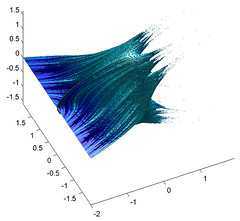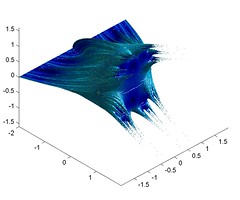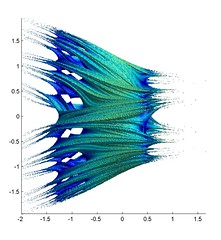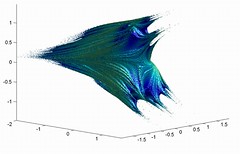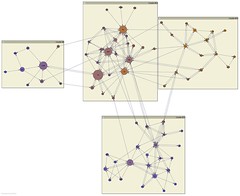February 29, 2008
Longevity Dividend Transcript Up
 Last summer I did a talk about scenario planning for the emergence of life extension (based on a mini-workshop with Extrobritannia). Now, courtesy of IEET a transcript (with audio) is online: Future Current » Blog Archive » Policy Scenarios for the Longevity Dividend
Last summer I did a talk about scenario planning for the emergence of life extension (based on a mini-workshop with Extrobritannia). Now, courtesy of IEET a transcript (with audio) is online: Future Current » Blog Archive » Policy Scenarios for the Longevity Dividend
On the Mprize site Reason makes the point that life extension will be unexpected if the advocates have not done their jobs, but that developing it will be such a big project that it will not be a Dolly-surprise. Maybe. But there are many big things that creep up slowly and seem to cause policy surprises despite massive coverage. Just think about the Internet, the Y2K bug or climate change. I think we should be prepared for quick transitions both in technology and opinion: good advocacy uses strategies that work in all four scenarios.
Overall, I think that is the often overlooked lesson of scenario planning ("that horrible thing"): use it to think about what happens in all scenarios, the kind of actions that always make sense. As well as how to make that strategy open to change when we find out that we ended up in scenario X - or outside our chart.
February 22, 2008
Sinister Commie Ducks!
 A Soviet Poster A Day: I'm so crazy I don't know this isn't possible shows the true threat: sinister communist ducklings! Likely from space.
A Soviet Poster A Day: I'm so crazy I don't know this isn't possible shows the true threat: sinister communist ducklings! Likely from space.
Watch this picture while listening to March of the Sinister Ducks (by Alan Moore).
"Nasty and small: undeserving of life.
Ducks. Ducks. Quack-quack. Quack-quack.
They'll sneer at your hairstyle and sleep with your wife.
Ducks. Ducks. Quack-quack. Quack-quack.
Dressed in plaid jackets and horrible shoes,
Getting divorces and turning to booze.
Ducks. Ducks. Quack-quack. Quack-quack.
Ducks. Ducks. Quack-quack. Quack-quack."
Here in Oxford the ducks Know Their Rights and will loudly berate any rowing team who gets too close - the ducks claim the rivers. And they are taking over college after college. "I will be upholding the rights of the ducks with perhaps the odd ticking off if they do something especially bad." - poor Mr Rae, if he - or anybody else - only knew what the ducks truly are up to.
Speaking at Cambridge on Sunday
 I will be speaking at the Cambridge University Transhumanist Society about Cognitive Enhancement on Sunday.
I will be speaking at the Cambridge University Transhumanist Society about Cognitive Enhancement on Sunday.
Some notes that I did in response to a post on Samizdata:
Making drugs equally available is an interesting problem, since different people react to them differently (and doubtless some parents will refuse). Is it enough to have enhancement vouchers?
Deep down we of course have the issues surrounding mandatory education - if education is so good at making us autonomous individuals that it has to be mandatory, then some enhancers might eventually also contribute enough to this that they ought to be mandatory. While I think even most libertarians would agree vaccines are close to that level, I would expect that most of us are a bit less eager to force biomedical changes on people.
Safety is going to be an interesting issue, especially since the most promising target is the developing brain. All the current ethical problems about medication for the young are going to be twice as nasty for enhancement.
But the irony is that we think nothing of drinking tea and coffee, that various (often spurious) "brain training exercises" are widely used and parents happily eat diets supposed to make their kids better off (some of which actually can cause beneficial gene expression changes). Very little (if any) research looks at the ethics and safety of these methods. Or even the safety of education itself - it is not obvious or likely that it just has beneficial effects.
February 21, 2008
Breaches of Confidentiality
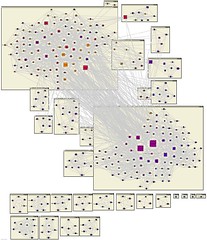 This week's CNE post was about Avandia leak affair. A reviewer leaked a damaging article about the drug to the manufacturer. Beside the bad form (and possible incompetence) it raises the problem of the actual, messy structure of how science is being done. If there were a neat distinction between independent scientists and corporate scientists (and institutions) competing interests would be easy to declare and monitor. But in reality the overlap, complex funding and non-monetary influences (from sponsorships to shared friends) makes the competing interests a continuum rather than binary.
This week's CNE post was about Avandia leak affair. A reviewer leaked a damaging article about the drug to the manufacturer. Beside the bad form (and possible incompetence) it raises the problem of the actual, messy structure of how science is being done. If there were a neat distinction between independent scientists and corporate scientists (and institutions) competing interests would be easy to declare and monitor. But in reality the overlap, complex funding and non-monetary influences (from sponsorships to shared friends) makes the competing interests a continuum rather than binary.
Is the fact that the first two months of my Ph.D. were paid for from the funding another research group received as part of a study from Cortex Pharmaceuticals enough to invalidate any ethical analysis I do about cognition enhancing drugs (they are researching ampakines) today, 10 years later? What about having a very nice lunch with someone who later joins a particular company or government agency? What about collegial ties as people move between pharma company and regulators?
In the end we have to judge papers and behavior on internal consistency, scientific quality and general ethical principles. We need to figure out ways of deciding that more efficiently so the inherent error-checking can overturn the creeping social biases.
And if the reviewer was right in his statement that he accidentally mailed the paper to the company, he needs some cognition enhancer. I wonder if ampakines might help?
February 13, 2008
Adaptive, Evidence-Based Climate Policy
 An old CNE post I forgot to post about here: Medical Climate Evangelism and Evidence Based Medicine. This one is about the BMJ:s call for doctors to become climate change evangelists.
An old CNE post I forgot to post about here: Medical Climate Evangelism and Evidence Based Medicine. This one is about the BMJ:s call for doctors to become climate change evangelists.
My annoyance with this is not so much that people care about the climate as trying to turn institutions that have particular purposes (such as medicine) into tools for this caring. Why not ensure that doctors are human rights evangelists, spreaders of the free (or regulated) market, and promoting literacy? While doctors can do good, one should not overload the core mission of the profession with too much. Especially since it would become the mouthpiece for whoever produces climate policy.
Oxford really is a hotbed of climate scepticism these days (cf The Wrong Trousers - Radically rethinking climate policy by Gwyn Prins and Steve Rayner). Mostly because of high standards of evidence and a dislike of decisionmaking done on weak grounds. The problem as Prins and Rayner points out is that there is plenty of political will and a defective political process ("The Kyoto Protocol failed because it is the wrong type of instrument ... relying too heavily on the wrong agents exercising the wrong sort of power"). There are also subtle issues of how to do climate modelling in order to learn something about the likely future, the inherent problems of getting convergence of the models in key areas and especially the disconnect between the physical climate and human outcomes. Of course, climate policy is relatively disconnected from the model science and the human outcome estimates, mainly using them as arguments for action rather than information for setting the right kind of action.
This is leading to a situation where we are going to hear very confident statements about risks and policies intended to ameliorate them, only to find that new results overturn the risks. This is to be expected given the properties of climate research (future-oriented, observation based, very non-linear, many levels of little understood interacting systems, lots of new data arriving) - but it is going to make specific policies look stupid and undermine confidence in the motivations for general policies.
A case in point is the recent report by the UK Department of Health that the increase in heat-related deaths in the UK may be offset by a decrease in cold-related deaths. It is also sanguine about malaria, while thinking there might be a 14.5% increase in Salmonella if food hygiene is not increased. Assuming this is actually based on real data and good models and not just spin, it contradicts a lot of the dire warnings about scorching death and tropical disease we hear. It also implies that adaptation should go a different way - but since it is based on evolving knowledge a report in a few years may tell us something different. Hence the only sane policy is to fix the things that make sense in all or most futures (like improving food safety) and assume greater variability about the level we have today (people might die more or less or heat or cold, so we should look at how to regulate our temperatures more cheaply; build to handle both more and less rain).
If doctors are to become climate evangelists they better think about making it evidence based.
Hmm, actually, maybe what we should aim for is something like the Cochrane Library for climate: independent high quality evidence to inform climate-related decision-making. Maybe climate policy can learn from medicine?
But that will mean that the policy has to be continually updated, something most decisionmakers don't like because it makes them look indecisive. They are elected to make decisions, hence they make them. So we need to make it worse for them to make the wrong decision and stick too long with it than to change decisions when the evidence no longer fits - that will likely keep down the number of unnecessary decisions too.
February 05, 2008
Freezing Away the Males
 Ambient temperature predicts sex ratios and male longevity -- Catalano et al., 10.1073/pnas.0710711104 -- Proceedings of the National Academy of Sciences
Ambient temperature predicts sex ratios and male longevity -- Catalano et al., 10.1073/pnas.0710711104 -- Proceedings of the National Academy of Sciences
Temperature affects the sex ratio of many species. There are also evolutionary arguments that stressed mothers would have a higher risk of spontaneous abortion (or non-conception) of male offspring, since they represent a smaller fitness gain than a daughter. Catalano, Bruckner and Smith looked at average temperature data from Scandinavia in the 1800's and compared it to gender ratios from the same and next year. They found an increase of one extra male per 1000 females born per degree of temperature.
Looking at the maps on the Wikipedia page about sex ratio per country suggests that high and low latitude countries more often have female-skewed gender ratios. But one should take that with a grain of salt, since clearly there are many other factors such as smoking, malnutrition, endocrine disruptors and deliberate selection at work here.
However, the serious Swedish famine in the 1860's doesn't seem to have made much of a mark in the data. The droughts of 1888 seem to have made a much clearer mark in the secondary sex ratio. There seems to be a very neat correlation between the temperatures, gender ratio and emigration from Sweden. I wonder if the emigration would act as a confounder?
The Julia-Mandelbrot Set
The Mandelbrot set is defined as those complex number c where the sequence zn+1=zn2+c, starting with z0=0, does not diverge to infinity. The Julia set for a complex number c is defined as the starting points z0 where the sequence does not diverge. Both are kind of dual to each other, and at least the Mandelbrot set often looks locally just like corresponding Julia sets.
Another way of viewing this is to join them into a four-dimensional set inhabiting C2: the set of points that for a given c and z0 do not diverge. Here are some crude images of sections through it:
These are sections in the imag(c)=0 hyperplane. They can be viewed as stacks of Julia sets along the real line, ranging from the line set at c=-2 over the San Marco fractal and unit circle to the c=1/4 blanchemange, which implodes to Fatou dust - in this picture the long feelers extending in the positive c direction. Note the neat parabola touching the c=-2 line.
If we move to the imag(c)=0.4 hyperplane we get more twisting, and the c=-2 line dissolves into dust-tendrils. The overall shape remains, but as the hyperplane moves towards increasing imaginary levels the whole thing twists into ever thinner dust.
Looking from the perspective of changing z0 rather than c, we get the following shapes:



The "equator" is the Mandelbrot set, and as z0 changes it warps in different ways. The last picture shows a plane with imag(z0)=0.4.
It is possible to plot the intersection between the set and random hyperplanes too, revealing a bit of its "generic" appearance:

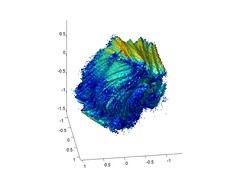
I made this using Matlab, plotting isosurfaces of convergence vs. nonconvergence. Very non-optimized code, slow plotting and produces plenty of artefacts, but a quick hack. Properly it should be raytraced or at least run as a z-buffer rendering. The color denotes the smallest magnitude an iterate achieved .
February 04, 2008
Meet Mom, Mom and Mom
 On Practical ethics I blogged Meet Mom, Mom and Mom: is there anything wrong with same-sex genetic parents?
On Practical ethics I blogged Meet Mom, Mom and Mom: is there anything wrong with same-sex genetic parents?
Unsurprisingly I don't think so (beside the obvious safety problems today, and maybe a matter of what should be in public healthcare). I think Monthy Python got it right, except that it is a negative right rather than a positive one:
STAN
It's every man's right to have babies if he wants them.
REG
But you can't have babies.
STAN
Don't you oppress me.
REG
I'm not oppressing you, Stan -- you haven't got a womb. Where's the fetus going to gestate? You going to keep it in a box?
(STAN starts crying.)
JUDITH
Here! I've got an idea. Suppose you agree that he can't actually have babies, not having a womb, which is nobody's fault, not even the Romans', but that he can have the *right* to have babies.
FRANCIS
Good idea, Judith. We shall fight the oppressors for your right to have babies, brother. Sister, sorry.
The real threat is of course that somebody extends Mother's Day and Father's Day to Surrogate Mother's Day, Oocyte-Father/Mother's Day and who knows what else.
Beware the Blinkenlichten
 I have just bought a Maxtor Onetouch 4 hard drive to act as a backup. So far so good... except that it is turning night into day. If I leave my computer on overnight (such as for making an initial backup) it produces the following light:
I have just bought a Maxtor Onetouch 4 hard drive to act as a backup. So far so good... except that it is turning night into day. If I leave my computer on overnight (such as for making an initial backup) it produces the following light:
- The hard drive has a bight white LED that blinks when it works
- The Belkin powerstrip has a green LED to signal that it works, as well as an orange light in the on-off button.
- The other power strip just has one big green light, but it flickers slightly.
- The keyboard has a small orange LED.
- The mouse shines slightly red.
- The computer has a big green light on the front plus a smaller LED
- There is a green light on the back too.
- The wireless has a LED that flickers.
- One or two power supplies also have green LEDs.
- Each of the external hard drives (Maxtors too) have a blue light that starts to blink when the drive is not used.
Add to this that my cellphone blinks discreetly in green, my home wireless phone recharger shines brightly red and my laptop in hibernation mode blinks yellow.
My bedrom looks like a mad scientist disco from some schlocky 80's horror movie: it is filled with eerie green light, blinking in complex rhythms. Might be a nice ambience, except when trying to sleep - as soon as my eyes dark adapt the whole room becomes quite distracting. It reaches levels where medical papers are actually starting to see epidemiological effects due to reduced melatonin production. Yet my computer system is fairly modest.
(And no, I do not have another room to put the computer in)
This is indoor light pollution. We are justly annoyed by loud computers, but what about visually polluting ones? We have finally got away from the beige boxes to nicer cases - but try finding one without lots of garish lights.
These lights all serve to indicate one thing: that a particular device is working. But they cannot be turned off except by covering them with black tape. They are wasting energy and stealing attention. I have a strong feeling we need to figure out a better way of indicating function than emiting energy.
February 03, 2008
Surely, anything that improves the ability to learn is a good thing
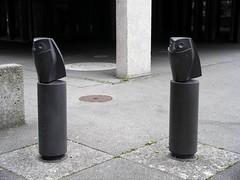 I'm in the Times Educational Supplement, in an article titled Artificial intelligence, dealing with cognition enhancement in schools. Perhaps not anything new for any of you who have read my other talks and papers, but at least I got the last word.
I'm in the Times Educational Supplement, in an article titled Artificial intelligence, dealing with cognition enhancement in schools. Perhaps not anything new for any of you who have read my other talks and papers, but at least I got the last word.
I think it is important to start thinking about what we actually want to do with education. Educators certainly have a lot of views on this, as do the public, but it might be worthwhile to start an ongoing debate about this between all the stakeholder groups (including the pupils) in the light of both the changes in information availability (not just more, but entirely different kinds and with different kinds of epistemology - wikiknowledge is different from other kinds in important ways) and cognition enhancement. Is education about knowledge acquisition? Or socialisation? Or bootstrapping kids into people with reasonable chances to live a good life? A competitive selection process or a cooperative effort? Depending on what people come up with, very different systems and applications of cognition enhancement are needed.
February 01, 2008
Connecting With the Macaque
While I'm still at posting my latest renderings and Flickr stuff, here is some a graph of the brain connectivity of the Macaque (click for a larger version):
This is based on the data in the brainmaps.org table of macaca mulatta connectivity. Each node is a brain area, with size denoting betweenness centrality and colour denoting graph distance from the visual cortex. yEd's grouping algorithm has been used to cluster groups of nodes.
The two big orange nodes are claustrum and the reticular nucleus of thalamus. Their cluster contains lots of visual cortex. The cluster below it contains somatosensory cortex, the one to the lower left seems to be motoric, the one above it seems to be secondary somatosensory. The one on top of that (left of the big cluster) seems to be cingulate cortex. This is nicely connected to the medial temporal system, which constitutes the three clusters to the upper left (the right centers on entorhinal cortex, the upper left is dentate gyrus and the lower left is cornu ammonis and subiculum feeding back). The small nodes on top are parasubiculum and presubiculum and area 31, limbic structures that in reality have many more connections.
Overall, I'm pretty impressed by how the clustering manages to get a rough outline of different systems. But the claustrum and reticular nodes seem to be hogging the network. So I tried removing them, and got this:
The result is just four big clusters. The right cluster is heavily visual, the lower cluster is somatosensory and motoric, the middle cluster limbic and the left cluster is the hippocampal system.
Running a second pass of clustering neatly divides the lower group into a motoric, primary somatosensory and a secondary somatosensory cluster. The limbic cluster divides into a MTL and a cingulate cluster, while the visual splits into a primary cluster, a temporal and a parietal cluster. Very cool.
Now the question is whether this is due to real differences in connectivity or that people have simply researched the connections that would make sense. How many have looked for a direct hippocampus-V1 connection?
Should Old Aquinas Be Forgot?
 On David Chalmer's blog fragments of consciousness there was a mention of "Should Old Aquinas Be Forgot?". This is apparently a philosophy filk, and in the comments are mentions of a few more. This is good news, as I have previously decried the lack of philosophy filk.
On David Chalmer's blog fragments of consciousness there was a mention of "Should Old Aquinas Be Forgot?". This is apparently a philosophy filk, and in the comments are mentions of a few more. This is good news, as I have previously decried the lack of philosophy filk.
The next step is of course to get mp3s of these. Or youtube videos. Beside the Wittgenstein March by M.A. Numminen and a piano rendition of Kant's Transcendental Unity of Apperception my collection is pretty bare. Not that I expect any great musical beauty; as I mentioned earlier academics on average are likely better at research than singing (still, renditions like the little Incompetent Design song almost makes me want to become a creationist, just like Stallman's rendition of the Free Software Song has made me appreciate Windows :-)
On the same blog there is also a nice frivolity, Philosophy teams. I'm in the topographical team, of course (I think a majority of Swedish philosophers would be).
